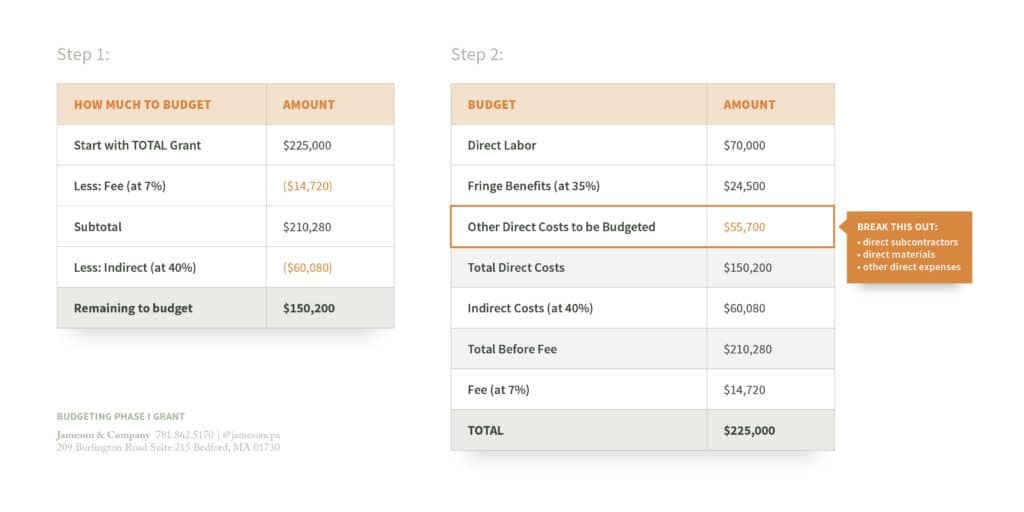How To Propose F&A Rates To Avoid Bankrupting Your NIH SBIR Grant
DON’T DIG YOURSELF A HOLE BEFORE YOU START!
Putting together an NIH SBIR/STTR grant cost proposal can be daunting. Most people falsely worry that if their fringe and F&A rates are too high, they won’t be competitive. Fact – the SBIR program is the government’s least cost sensitive program.
Critical to your survival – unless you negotiate an indirect rate, your fringe and F&A rates will be capped at whatever you propose. If your indirect rates are proposed too low, you will have cash flow problems and may jeopardize your business.
Starting to work on your cost proposal early in the grant writing process is critical to getting it right.
START WITH A 35% FRINGE and 40% F&A RATE
From our decades of experience, NIH SBIR/STTR grants are allowed to take up to a 40% (unmodified) F&A rate and a fringe benefit rate of 35% without question. To give yourself maximum flexibility – use these figures as the starting point to your cost proposal. You can always re-budget monies out of your indirect cost budget categories and into direct budget categories. But NOT the other way around.
Step 1. Start with the maximum award amount and work backwards. Let’s assume your total award amount will be $225,000. Reduce the $225,000 by the 7% fee and the 40% F&A, as follows: $225,000 divided by 1.07 divided by 1.40 = $150,200. The result of $150,200 represents the remaining amount of funds to be budgeted on direct project costs (plus fringe benefits which the agency displays as a direct cost on their proposal template).
Step 2. Next, figure out how much direct labor (plus 35% for fringe benefits) to budget. Keep in mind that direct labor costs are not the same as total labor costs! Let’s assume that your total pay is $100,000 and you will spend 70% of your effort on this project, with other 30% of your time managing the business. In this example, your direct labor is $70,000 and your fringe benefits are simply calculated by multiplying the direct labor by your 35% fringe rate: $70,000 x 35% = $24,500.
You now have $55,700 ($150,200 – $70,000 – $24,500) to budget in other categories like direct materials. direct consultants, direct subcontractors, and so on.

FINAL TIPS FOR BUDGETING YOUR NIH GRANT PROPOSAL
A few final tips when preparing your NIH SBIR/STTR Grant cost proposal:
1. Start with the high-level budget category total numbers first, then figure out the details later. For example, if you start looking at how many trips to which city at what cost per trip, you will get lost in the weeds. You can nail those details down after you have the big picture right.
2. Remember this budget is not set in stone! If you win the award, you can subsequently re-budget. Keep in mind that you can reduce your indirect cost budget and increase your direct costs budget, however you can’t go in the other direction.
WE’RE HERE TO HELP
We’re experts in NIH SBIR/STTR grant proposals and are happy to donate 10 minutes reviewing your cost proposal as long as you can get it to us a week in advance.
Want an expert to review your cost proposal. Start by downloading our free, easy to use indirect rate projection templates. Click here to access the templates.
Ready to Learn More? Speak With A Government Funding Award Expert!
Call Now: 781-862-5170 – or – Schedule A Call

I’ve been in practice for over 40 years helping our small business clients procure, manage, and survive audits on more than $6 billion in federal government contract and grant funding. We’ve been featured presenters and panel moderators at Tech Connect’s National SBIR/STTR conferences since 2010, and I’ve presented at the DOD’s Mentor Protégé Summit and present regularly for several state and local organizations.
GET THE SOLUTION YOU NEED NOW
Learn more about how we can support your needs and objectives. Join us for an enlightening discussion and take the first step towards a partnership that can make a difference.
JOIN OUR NEXT WEBINAR
Join us for an upcoming webinar where we’ll dive deep into the latest insights and strategies.
Reserve your spot today and take a step toward gaining valuable knowledge that can make a real impact.